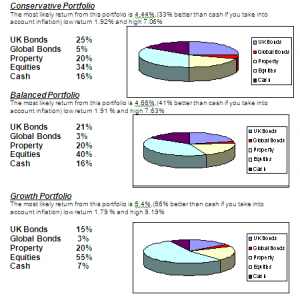May I wish you all a Happy Christmas!
I started this year with an article on Financial Planning and I intend to end the year in the same vein.
One of the essences of a financial plan is to set targets and to make assumptions as to how you may reach those targets. In making the assumptions the client and the adviser need to make decisions on interest rates, will they rise or fall, inflation, long-term growth of the economy and house prices. All this is difficult and sometimes we feel as if we need a crystal ball. However, the essential element is that this is discussed between the client and the adviser and when added into an asset allocation which takes into account the client’s attitude to risk, should give a more realistic outcome than the key facts documents produced by Insurance Companies under the direction of the FSA.
Many clients become dis-satisfied with financial products because they have un-realistic ideas of the returns they may receive. They fail to understand that it is not possible to obtain 10%per annum after charges and inflation – you may think I am joking but this is the expectation of some people and when faced by realistic figures actually throw in the towel and say it is not worth doing at all.
If you are to have a financial plan, you need an asset allocation with which you feel comfortable. If you look at the table below you will see that by increasing the risk you can increase the expected return. Although the difference looks small, the compounding effect over time does mean that the higher risk portfolio will considerably out-perform but there will be times when the value of the portfolio will fall.

The other key facet of an asset allocation strategy is that it is regularly reviewed and rebalance. It may be difficult for a client to contemplate selling some equity holding when the market is roaring ahead to buy boring fixed interest securities but in the long run when the bull market has run its course, the rebalancing will have reduced risk.
Do talk to us if you want to know more about drawing up an asset allocation for your portfolio
